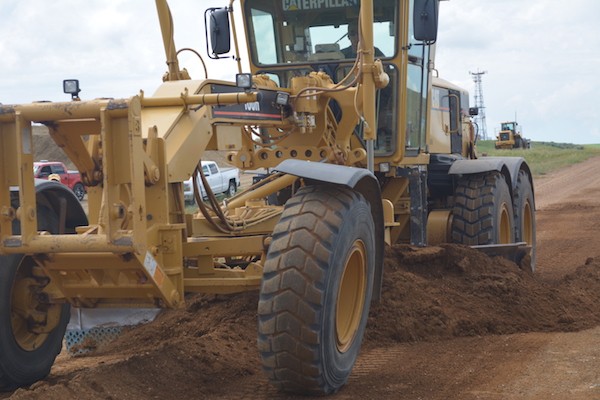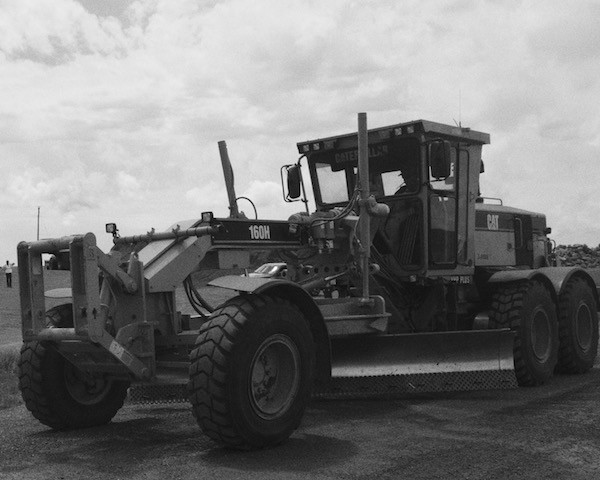When it comes to grader blades you have two important choices to make. What is the right material and what is the best blade type for your application? Choosing the correct blades makes a great difference in motor grader performance and overall productivity. DMC Wear Parts offers a variety of grader blades that can save you time and money with three different composite materials:
Grader Blade Types
BluSteel Grader System
The BluSteel grader blade system solves all road grading needs while extending blade wear life, reducing fuel expenses, and saving time! This grader system can quickly transform your grading equipment into any style of cutting edge with 6 different blades profiles.
Carbide Insert Grader Blades
Carbide grader blades are built for maximum wear life in high abrasion or low impact applications. These cutting edges are designed with a tungsten carbide insert and overlay to increase the wear life of the blade serval times longer than conventional steel blades.
Heat-Treated Steel Grader Blades
Steel grader blades are used for most types of road grading or earthmoving applications. Heat-treated steel is an inexpensive option that provides efficient performance for cutting edge applications.
Road Grader Blade Styles
While the proper metal selection is important, the application and environment will often determine which style of blade is needed for your project. Impact, ground penetration, and abrasion resistance will define the prerequisites of your cutting edge. Your selection for grader blades has to penetrate the ground material, not wear excessively, and remain intact during impact operation.
Using the right style of blade for your application will help you buy fewer edges, have less downtime and spend less money on labor and hardware. DMC Wear Parts carries the following styles of blades:
- Flat Edges – best suited for applications when the material does not need to be carried to be redistributed and for ditching or general gravel maintenance.
- Serrated Edges – best suited for applications when increased ground penetration is required to move surface materials.
- Curved Edges – best suited for applications when existing material is carried and redistributed along the top layer to create a smooth and flat finished road surface.
- Scarifier Edges – best suited for applications when the ground is heavily compacted, contains heavy rocks, is paved with asphalt or has heavy ice.
- Corrugated Edges – BluSteel BX500 (corrugated) blades best suited for applications when mixing material (such as ice or vegetation) is beneficial for improving the road.

Customer Testimonial

“From an operators standpoint conditions are always changing and with the Borox blue steel you have the ability to adapt to different conditions by switching between different cutting-edge styles and thicknesses easily. From a shop foreman standpoint less down pressure to do the job means less wear and tear on the machine, which translates to savings in the long run!”
– Stuart | Road Foreman | North Dakota, USA
With over 20 years of experience, we understand your needs and can help you get the correct road grading equipment for your job. Let us put our knowledge to work for you!
![]() Quick Quotes
Quick Quotes
![]() (605) 840-8082
(605) 840-8082
![]() American Owned
American Owned
Why Is Road Grading Important?
Road grading is a method of maintaining and leveling an unpaved road surface. Road grading is essential before a road is paved or for permanent dirt/gravel roads.
When vehicles drive on an unpaved road, the surface material can become displaced, causing potholes, washboard bumps, and uneven surfaces. Roads that are not properly maintained have an increased risk of accidents and are more susceptible during wet or icy conditions. Shaping the road surface is also crucial for proper drainage, salt/sand distribution, and controlling surface moisture. Road grading results in safer roads with improved traction, proper drainage, and better driving conditions.

Summer Road Maintenance (Road Building & Maintenance)
- A thin blade and sharp edge can penetrate soft ground material with little to no down pressure – which saves you time and reduces fuel expenses.
- A thin and flat blade can be used to cut and reshape the road as well as pull ditches – which will reduce the amount of future road maintenance and increase flexibility.
- A serrated blade can penetrate the ground and bring up more materials to distribute over potholes and wheel ruts – which can reduce future maintenance and get the job completed in less passes
- A corrugated style blade will allow vegetation, fines, and roughage to flow through the holes of the blade – which creates a good mix of surface materials for the roadbed. This style of blade also gives the best cut because it refreshes as it wears, similar to scarifier teeth.
- A flat or curved blade will roll the material along the face of the blade which mixes the fines and redistributes them evenly across the road.
Winter Road Maintenance (Ice & Snow)
- Corrugated, scarifier, or thin grader blades allow operators to easily cut through the ice to remove it with very little down pressure – which saves you time and reduces fuel expenses
- Grader blades can push snow packs while breaking through the frozen ground – which allows sand or salt to react with the surface much quicker.
- Road grading will open up the road surface allowing for grooves that keep salt or sand from being blown off the road by wind or traffic – which reduces your costs on salt/sand while keeping drainage cleaner.
- Thin and sharp grader blades reduce friction and heat – which can otherwise cause the road to become slippery or refreeze as ice patches.
- BluSteel cutting edges reduce the downward pressure required – which allows operators better traction without tire chains.
Common Issues With Grader Blades
Crowning
Crowning is a typical blade wear pattern that occurs when a cutting edge conforms to the profile of the road being graded. When extreme crowning occurs some operators may opt to try a narrower and/or thinner cutting edge. But an additional step that allows more play in your blades is to use shorter blades (36-48in lengths) that can be rotated inside out, flipped over or inverted to maximize your wear.
Wrong Thickness
The thickness of your cutting edge should be determined by the penetration requirements for your project. Harder or higher impact surfaces benefit from a thinner blade. The thinner blade makes it easier to penetrate the material. For easier surfaces, a thicker blade can be used to extend overall wear life.
Wrong Angle
The angle at which a grader blade is operated can make your job easier or harder. Each application will have an optimal range that keeps the blade sharpest and offer the best penetration. It is important to understand the best angle for your blade and application.
